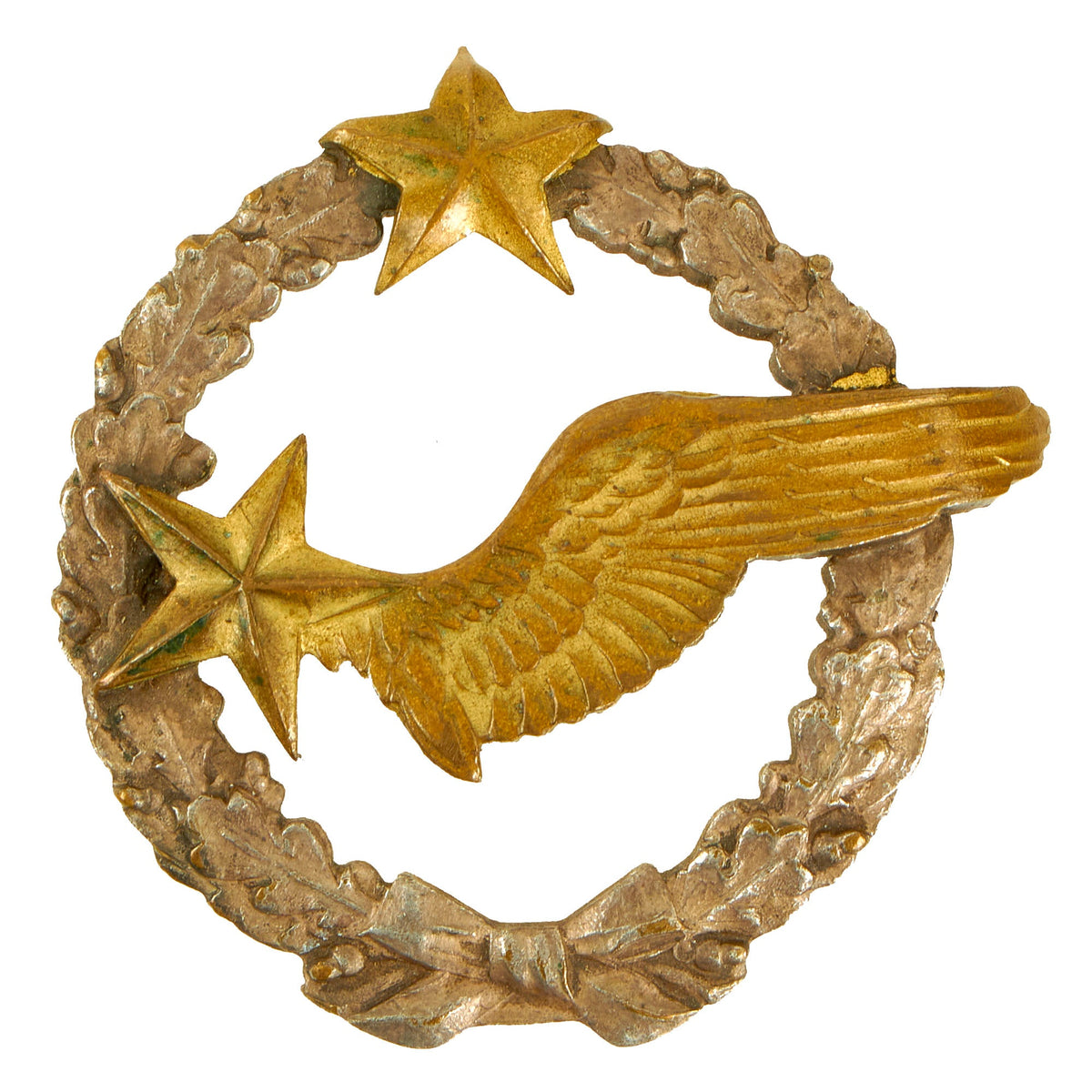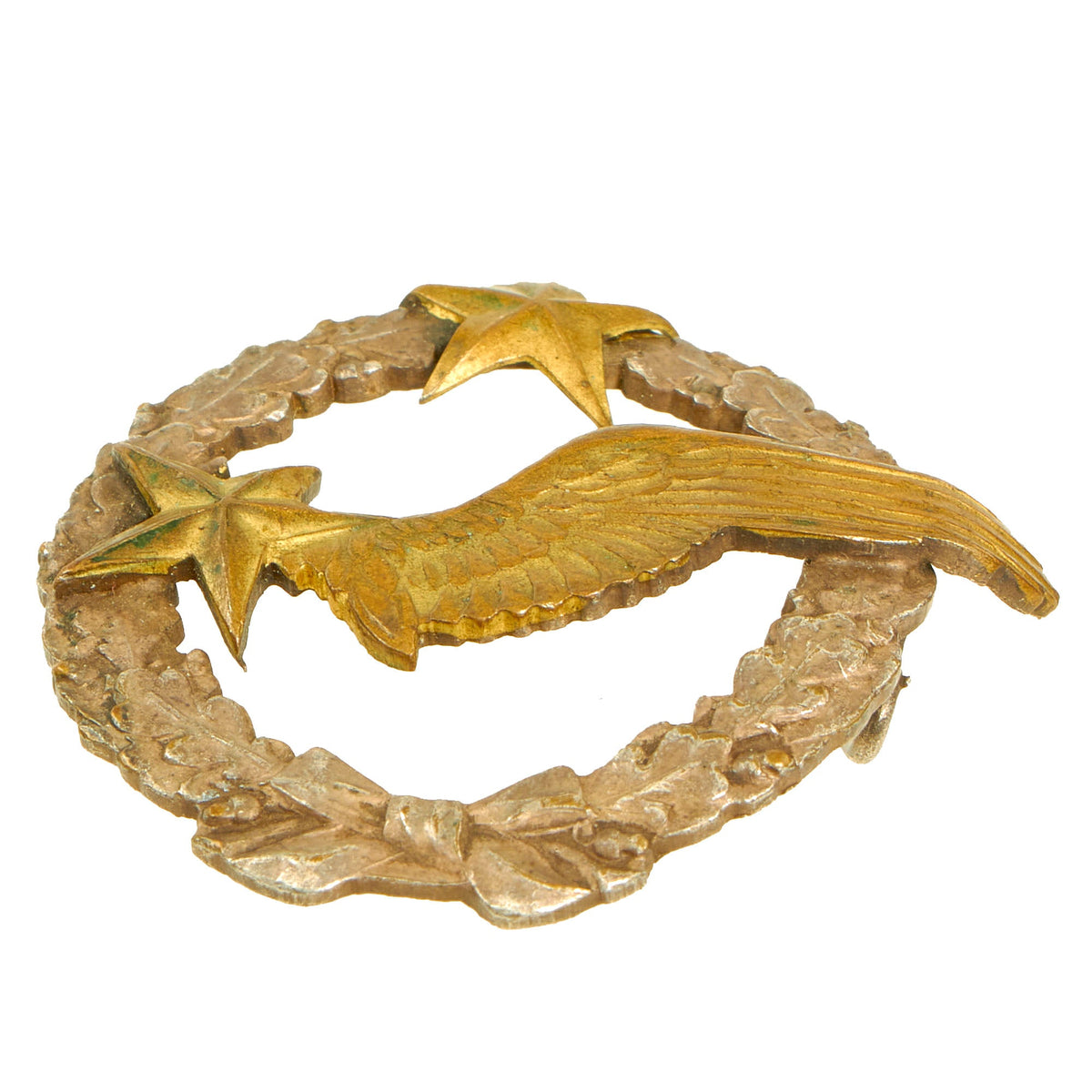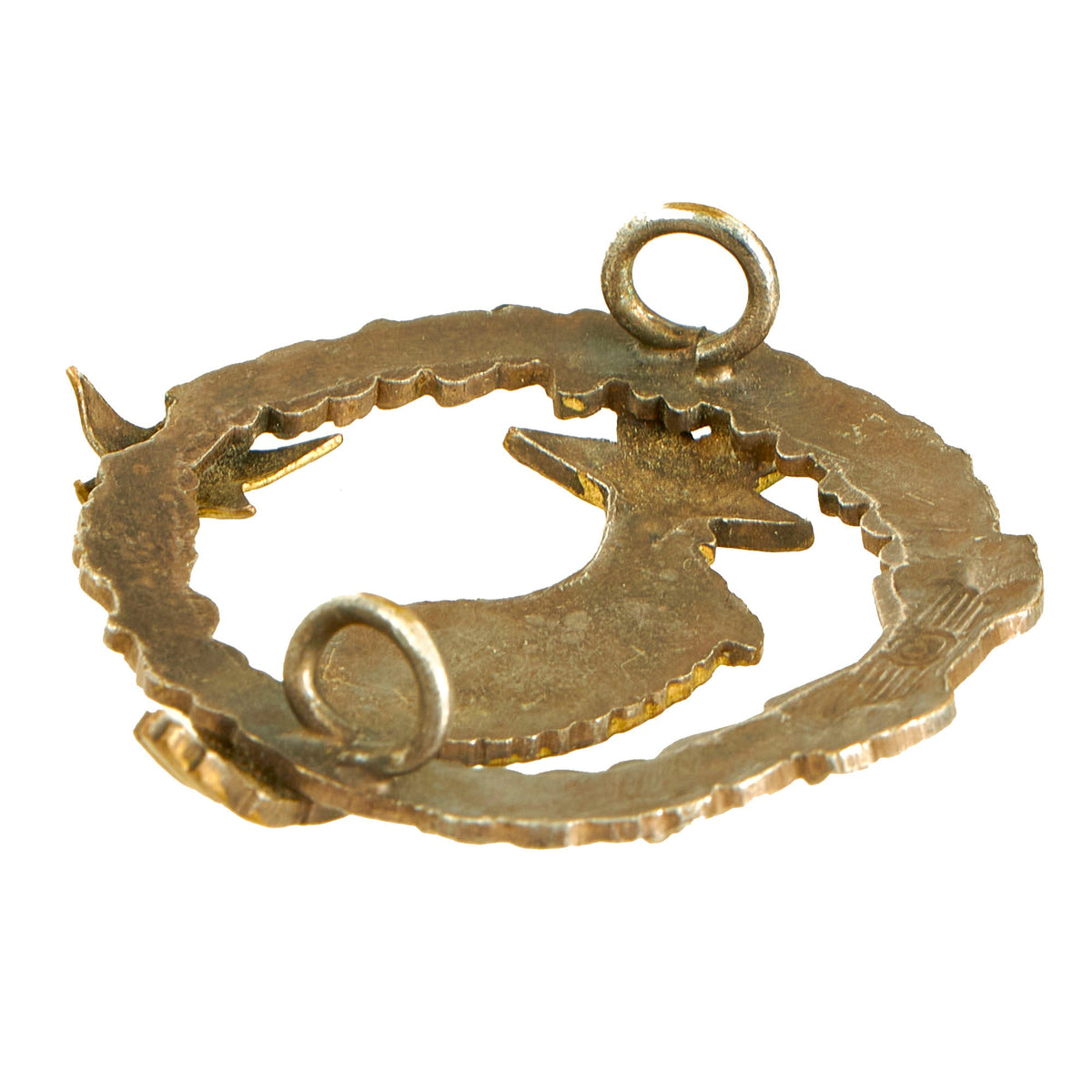Original French Pre-WWII Armée de l’Air French Air Force Aerial Observer Badge Original Items
$ 225,00 $ 90,00
Original Items: Only One Available. This is a fantastic inter war era French Air Force Aerial Observer badge. The WWI examples of these are almost nearly identical to this one in appearance, the only difference being the “Winged Star” is off center and the top wreath does not have a star present on it.
The badge itself features a German style Oak leaves laurel with a bow at the bottom center, the gilt Winged Star in the center and another gilt star applied at the top center. The badge is in wonderful condition, though it does show age, wear and tarnish. The “barbell” type fastening bar is unfortunately missing and the points of the top center star are bent inwards slightly, almost wrapping around the laurel.
A wonderful, rather scarce example ready for further research and display.
The Armée de l’Air (literally, ‘army of the air’) is the name used for the French Air Force in its native language since it was made independent of the Army in 1933. This article deals exclusively with the history of the French air force from its earliest beginnings until its destruction after the occupation of France. French naval aviation, the Aéronautique Navale is covered elsewhere.
The end of war may have brought peace to France, yet the country itself and its infrastructure had been ravaged by four years of warfare, and the scars left behind were not just physical. As a result, it took some time for industry to recover. Not unexpectedly, orders for military aeroplanes dropped after the Armistice, resulting in reductions being made to squadron strengths.
France had a Colonial empire extending around the globe, and it needed to be defended. Anti-Government elements in French Morocco were clamouring to expel the French. On 27 April 1925, therefore, alongside tactical and logistical support, air operations in Morocco were begun owing to the Rif War and they were to continue until December 1934.
In the 1930s, the French aeronautical industry was primarily composed of small companies such as Latécoère, Morane-Saulnier, Nieuport-Delage and Amiot, each only producing small numbers of aircraft. As a result, the French aeronautical industry proved itself incapable of delivering the aircraft that the annual fiscal budgets had called for which had been greatly increased as a result of AH coming to power in January 1933 and his remilitarization of Germany in defiance of the Allies and the Treaty of Versailles.
Pierre Cot, the secretary of the French Air Force, decreed that national security was too important for the production of warplanes to be left in the hands of the private enterprises that were thus far failing to meet production goals. In July 1936 the French government began nationalizing many of the larger aircraft companies, creating six state-owned companies, which encompassed the majority of aeronautical production, and regrouping those companies to their geographical regions. Bloch was nationalized in January 1937. However, the aircraft engine industry, even as it proved incapable of providing the badly needed powerful engines, escaped nationalization.
By 1937, it was clear that more modern aircraft were needed, since the air force was still flying relatively antiquated aircraft like the Dewoitine D.500 and orders to construct more than 2,500 modern machines, among them the Bloch MB.170 bomber and the Dewoitine D.520 fighter resulted. The inadequacy of the French aeronautical programs, as well as indecision in high command resulted in the French Air Force being in a position of weakness, confronting a modern and well organized Luftwaffe, which had just gained combat experience in the Spanish Civil War.
France attempted to respond to the likelihood of another European war via an intensive re-equipment and modernization program in 1938–39, as did other countries desperately in need of new aircraft including Poland whose 1939 orders of 160 MS-406 fighters from France still hadn’t been delivered by the German invasion of Poland. Germany production outstripped that of its neighbours, so it was a question of “too little, too late” as far as the French – as well as the whole continent of Europe – were concerned.
An attempt was made to purchase the latest American bombers and fighters – or at least fighter planes. American planes were 50% more expensive than French models, and no superior models were for sale. U.S. law required cash purchases, and the French finance ministry opposed using its gold reserves for this purpose. French labor unions refused to lengthen its 40-hour week, and were strongly opposed to imports that would reverse the growth of jobs in the French defense industry. In any case, the American aviation industry was too small and too committed to orders from American forces to be of any help. Inevitably, the French industrial response fell far behind the German threat. The British aircraft industry was working all out to rearm British forces.
Fast Shipping with Professional Packaging
Thanks to our longstanding association with UPS FedEx DHL, and other major international carriers, we are able to provide a range of shipping options. Our warehouse staff is expertly trained and will wrap your products according to our exact and precise specifications. Prior to shipping, your goods will be thoroughly examined and securely secured. We ship to thousands clients each day across multiple countries. This shows how we're dedicated to be the largest retailer on the internet. Warehouses and distribution centres can be located throughout Europe as well as the USA.
Note: Orders with more than one item will be assigned a processing date depending on the item.
Before shipping before shipping, we'll conduct a thorough inspection of the items you have ordered. Today, the majority of orders will be delivered within 48 hours. The delivery time will be between 3-7 days.
Returns
The stock is dynamic and we cannot completely manage it because multiple stakeholders are involved, including our factory and warehouse. So the actual stock may alter at any time. It's possible that you may not receive your order once the order has been made.
Our policy is valid for a period of 30 days. If you don't receive the product within 30 days, we are not able to issue a refund or an exchange.
You can only return an item if it is unused and in the same state as the day you received it. You must have the item in its original packaging.
Related products
Uncategorized
Uncategorized
Uncategorized
Uncategorized
Uncategorized
Armored Burgonet Helmet & Polearm from Scottish Castle Leith Hall Circa 1700 Original Items
Uncategorized
Uncategorized
Uncategorized
Uncategorized
Uncategorized
Uncategorized
Armoured Fighting Vehicles of the World: AFVs of World War One (Hardcover Book) New Made Items
Uncategorized
Uncategorized
Uncategorized
Band of Brothers ORIGINAL GERMAN WWII Le. F.H. 18 10.5cm ARTILLERY PIECE Original Items
Uncategorized
Uncategorized
Uncategorized
Uncategorized








































































